Old Bailey
| Central Criminal Court of England and Wales | |
|---|---|
| Old Bailey | |
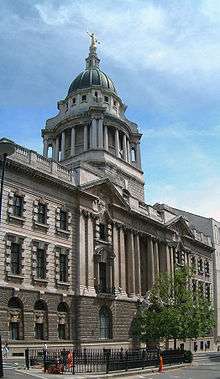 The Old Bailey in 2004 | |
| Jurisdiction | England and Wales |
| Location | London, EC4 |
| Recorder of London | |
| Currently | Nicholas Hilliard |
| Since | 6 January 2015 |
The Central Criminal Court of England and Wales, commonly referred to as the Old Bailey from the street on which it stands, is a court in London and one of a number of buildings housing the Crown Court. Part of the present building stands on the site of the medieval Newgate gaol, on a road named Old Bailey that follows the line of the City of London's fortified wall (or bailey), which runs from Ludgate Hill to the junction of Newgate Street and Holborn Viaduct. The Old Bailey has been housed in several structures near this location since the sixteenth century, and its present building dates from 1902.
The Crown Court sitting at the Central Criminal Court deals with major criminal cases from within Greater London and in exceptional cases, from other parts of England and Wales. Trials at the Old Bailey, as at other courts, are open to the public; however, they are subject to stringent security procedures.
History
.jpg)
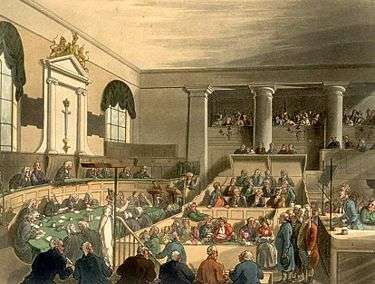
The court originated as the sessions house of the Lord Mayor and Sheriffs of the City of London and of Middlesex. The original medieval court was first mentioned in 1585; it was next to the older Newgate Prison, and seems to have grown out of the endowment to improve the gaol and rooms for the sheriffs, made possible by a gift from Richard Whittington. It was destroyed in the Great Fire of London in 1666 and rebuilt in 1674, with the court open to the weather to prevent the spread of disease.
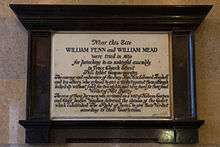
In 1734 it was refronted, enclosing the court and reducing the influence of spectators: this led to outbreaks of typhus, notably in 1750 when 60 people died, including the Lord Mayor and two judges. It was rebuilt again in 1774 and a second courtroom was added in 1824. Over 100,000 criminal trials were carried out at the Old Bailey between 1674 and 1834.[1]
In 1834, it was renamed as the Central Criminal Court and its jurisdiction extended beyond that of London and Middlesex to the whole of the English jurisdiction for trials of major cases. Her Majesty's Courts and Tribunals Service manages the courts and administers the trials but the building itself is owned by the City of London Corporation, which finances the building, the running of it, the staff and the maintenance out of their own resources.[2]
The court was originally intended as the site where only criminals accused of crimes committed in the City and Middlesex were tried. However, in 1856, there was public revulsion at the accusations against the doctor William Palmer that he was a poisoner and murderer. This led to fears that he could not receive a fair trial in his native Staffordshire. The Central Criminal Court Act 1856 was passed to enable his trial to be held at the Old Bailey.
In the 19th century, the Old Bailey was a courtroom adjacent to Newgate Prison. Hangings were a public spectacle in the street outside until May 1868. The condemned would be led along Dead Man's Walk between the prison and the court, and many were buried in the walk itself. Large, riotous crowds would gather and pelt the condemned with rotten fruit and vegetables and stones.[2] In 1807, 28 people were crushed to death after a pie-seller's stall overturned. A secret tunnel was subsequently created between the prison and St Sepulchre's church opposite, to allow the chaplain to minister to the condemned man without having to force his way through the crowds.[2]
The present Old Bailey building dates from 1902 but it was officially opened on 27 February 1907. It was designed by E. W. Mountford and built on the site of the infamous Newgate Prison, which was demolished to allow the court buildings to be constructed. Above the main entrance is inscribed the admonition: "Defend the Children of the Poor & Punish the Wrongdoer". King Edward VII opened the courthouse.
.jpg)
On the dome above the court stands a bronze statue of Lady Justice, executed by the British sculptor F. W. Pomeroy. She holds a sword in her right hand and the scales of justice in her left. The statue is popularly supposed to show blind Justice, however, the figure is not blindfolded: the courthouse brochures explain that this is because Lady Justice was originally not blindfolded, and because her "maidenly form" is supposed to guarantee her impartiality which renders the blindfold redundant.[3]
During the Blitz of World War II, the Old Bailey was bombed and severely damaged, but subsequent reconstruction work restored most of it in the early 1950s. In 1952, the restored interior of the Grand Hall of the Central Criminal Court was once again open. The interior of the Great Hall (underneath the dome) is decorated with paintings commemorating the Blitz, as well as quasi-historical scenes of St Paul's Cathedral with nobles outside. Running around the entire hall are a series of axioms, some of biblical reference. They read:
- "The law of the wise is a fountain of life"
- "The welfare of the people is supreme"
- "Right lives by law and law subsists by power"
- "Poise the cause in justice's equal scales"
- "Moses gave unto the people the laws of God"
- "London shall have all its ancient rights"
The Great Hall (and the floor beneath it) is also decorated with many busts and statues, chiefly of British monarchs, but also of legal figures, and those who achieved renown by campaigning for improvement in prison conditions in the eighteenth and nineteenth centuries. This part of the building also houses the shorthand-writers' offices.
The lower level also hosts a minor exhibition on the history of the Old Bailey and Newgate featuring historical prison artefacts.
In 1973, the Belfast Brigade of the Provisional IRA exploded a car bomb in the street outside the courts, killing one and injuring 200 people. A shard of glass is preserved as a reminder, embedded in the wall at the top of the main stairs.[2]
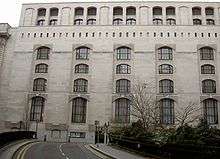
Between 1968 and 1972, a new South Block, designed by the architects Donald McMorran and George Whitby, was built to accommodate more modern courts. There are presently 18 courts in use. Court 19 is now used variously as a press overflow facility, as a registration room for first-day jurors or as a holding area for serving jurors.
The original ceremonial gates to the 1907 part of the building are only used by the Lord Mayor and visiting royalty. The general entrance to the building is a few yards down the road in the South Block and is often featured as a backdrop in television news reports. There is also a separate rear entrance, not open to the public, which permits more discreet access. In Warwick Square, on the western side of the complex, is the "Lord Mayor's Entrance".
A remnant of the city wall is preserved in the basement beneath the cells.
Management
Until 2017 the court manager was known by the title of the Secondary of the City of London, an ancient title of a City officer.[4] Today the more prosaic 'Head of Operations' is used.
Judges
All judges sitting in the Old Bailey are addressed as "My Lord" or "My Lady" whether they are High Court, circuit judges or recorders. The Lord Mayor and aldermen of the City of London are entitled to sit on the judges' bench during a hearing but do not participate in hearings. By tradition the judge sits slightly off-centre in case the Lord Mayor decides to come in; if he did he would take the centre chair.
The most senior permanent judge of the Central Criminal Court has the title of Recorder of London, and his deputy has the title of Common Serjeant of London. The position of "Recorder of London" is distinct from that of a recorder, which is a part-time judicial office, holders of which sit part-time as judges of the Crown or county courts. Some of the most senior criminal lawyers in the country sit as recorders in the Central Criminal Court.
As of 2015 the Recorder of London is Judge Nicholas Hilliard QC, MA,[5] who took over as the Recorder of London on the retirement of Judge Brian Barker who took over on the retirement of Judge Peter Beaumont CBE QC, appointed in December 2004 following the death of his predecessor, Judge Michael Hyam. From 1975 to 1990 the very outspoken Sir James Miskin served as the Recorder of London with a number of controversial cases coming before him.[6]
Civic role
The court house originated as part of the City of London's borough judicial system, and it remains so. The Recorder and the Common Serjeant are both City officers, and the Recorder is a member of the Common Council because he is also a member of the Court of Aldermen. The City's sheriffs and the Lord Mayor are justices there, but their jurisdiction is now nominal. The sheriffs are resident with the senior judges in the complex. In Court Number 1, there are several benches set aside for the committee of the Bridge House Estates, which is the actual owner of the building.
In popular culture
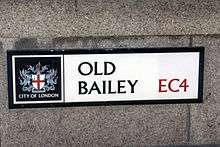
As the court in which the most serious criminal cases in London, and often the whole of England and Wales, have been heard for centuries, there are many references to the Old Bailey.
- In the book A Tale of Two Cities by Charles Dickens, the Old Bailey is the courthouse named in the book where Charles Darnay is put on trial for treason.
- In Act Two of Gilbert and Sullivan's The Pirates of Penzance, after the pirates defeat the police in a brief struggle, the two sides sing that "No pirate band will take its stand/At the Central Criminal Court."
- In the movies The Paradine Case and Witness for the Prosecution, the court scenes are set in the Old Bailey.
- In the novel Patriot Games and the eponymous film, terrorist Sean Miller is tried in the Old Bailey for the attempted kidnapping of the Prince & Princess of Wales (which killed two guards), and sentenced to life in prison after Jack Ryan's testimony. (Ryan foiled the plot by disabling Miller and using Miller's gun to kill Miller's brother.)
- In the book Season of Migration to the North by Tayeb Salih, Mustafa Sa'eed was tried in the Old Bailey for the crime of murdering his English wife Jean Morris and was sentenced to seven years imprisonment.
- The Old Bailey is destroyed with explosives by the vigilante V in the graphic novel V for Vendetta and its film adaptation. In the graphic novel, V entertains a long, one-sided conversation with the statue of Justice on the roof, in which he professes his love for her but accuses her of being a whore for the fictional fascist government, and tells her of his new mistress named Anarchy.
- The television series Rumpole of the Bailey, which starred Leo McKern, concerned a defence lawyer who works at the Bailey. Sir John Mortimer, a criminal barrister and author, often appeared at the Old Bailey. His courtroom experiences led him to create the fictional character Horace Rumpole.
- In N. F. Simpson's play One Way Pendulum, Arthur Groomkirby builds a replica of the Old Bailey in his living room, in which his son Kirby is later tried for mass murder.
- In the popular Australian folk song "Botany Bay," the first verse references the "well-known Old Bailey." The song tells the tale of a group of prisoners being taken from Britain to the penal colonies of Australia, to be exiled there.
- In the television series Bad Girls, the character Nikki Wade's successful appeal took place at the Old Bailey.
- The book Neverwhere, written by Neil Gaiman, has a character named Old Bailey.
- In the television series Law & Order: UK several interior scenes are shot in the Grand Hall of the Central Criminal Court, with the murals and axioms clearly visible.
- The entire sketch "Court Charades" from the British comedy show Monty Python's Flying Circus happens at the Old Bailey, appearing when it is showing the arrival of the Spanish Inquisition.
- It is featured in the rhyme "Oranges and Lemons," which, in turn, is featured in George Orwell's Nineteen Eighty-Four. In the novel, the Old Bailey has been renamed the "Palace of Justice" where "thoughtcriminals" are periodically tried, convicted and sentenced to death.
- In the Leon Uris novel QB VII, the courtrooms in the Old Bailey feature prominently.
- In the novel Error of Judgement, written by Dexter Dias, the Old Bailey is the court in which the main trial against a mentally ill murderer is held.
- In Leon Garfield's Smith, the setting is at some point in Old Bailey.
- In the television series Garrow's Law, a fictional retelling of the life of an 18th-century barrister, William Garrow, many of the scenes take place within the Old Bailey.
- In the episode "The Reichenbach Fall" of the television series Sherlock, a BBC adaption of Arthur Conan Doyle's Sherlock Holmes, the Old Bailey is featured, though interior scenes were actually filmed elsewhere.
- In the 2011 murder mystery Death Comes to Pemberley, written by P. D. James, the 1804 trial for a murder committed in Derbyshire is held at the Old Bailey, even though, as explained above, venue would not have been proper at the Old Bailey at that time for a crime committed in a distant county.
- In the novel A Certain Justice by P. D. James, the Old Bailey features prominently as a site where the murdered barrister Venetia Aldridge often appeared in court. The primary characters and murder suspects Mr. Froggett and Mrs. Carpenters watched Ms. Aldridge in action in The Old Bailey.
- In the beginning of Pirates of the Caribbean: On Stranger Tides, Joshamee Gibbs is tried in the Old Bailey, and Jack Sparrow disguises himself as Justice Smith.
- In the historical novel Blackout/All Clear, written by Connie Willis, World War II child evacuee Alf Hodbin eventually becomes a justice at the Old Bailey.
- In the 1979 Stephen Sondheim musical Sweeney Todd: The Demon Barber of Fleet Street and its 2007 film adaptation, the story's antagonist, Turpin, is a judge working in the Old Bailey.
- In the novel A Prisoner of Birth, written by Jeffrey Archer, the trial of the murder case around which the story revolves is set at the Old Bailey.
- In The Execution of Gary Glitter, Gary Glitter (born Paul Francis Gadd) is tried at the Old Bailey for the sex crimes he was accused of committing in Vietnam.
- In The Increasingly Poor Decisions of Todd Margaret, Todd Margaret is tried at the Old Bailey.
- In the game Dai Gyakuten Saiban: Naruhodō Ryūnosuke no Bōken and its sequel Dai Gyakuten Saiban 2: Naruhodō Ryūnosuke no Kakugo, the main protagonist Naruhodō Ryūnosuke defends various clients at Old Bailey during his stay in London.
- In the Amazon original series ‘’A Very English Scandal’’ as the backdrop of the trial of disgraced former Liberal party leader Jeremy Thorpe, the first British politician to stand trial for conspiracy to murder.
See also
References
- ↑ Digitizing the Hanging Court. Guy Gugliotta, Smithsonian Magazine, April 2007.
- 1 2 3 4 James, David (31 January 2010). "It's murder every day in the Old Bailey". The Sunday Times magazine. London: Times Newspapers. pp. 20–26. Retrieved 7 February 2010.
- ↑ Colomb, Gregory. Designs on Truth, page 50 (Penn State Press, 1992).
- ↑ Secret London: The Secondary
- ↑ "Next Recorder of London announced".
- ↑ "Obituary: Sir James Miskin". The Independent.
External links
| Wikibooks has a book on the topic of: London:Old Bailey Trials |
| Wikimedia Commons has media related to Central Criminal Court. |
- Court information
- HM Courts Service – CCC – Daily Court Status
- The Proceedings of the Old Bailey London 1674 to 1913 – Archive of case details
- Central Criminal Court from the City of London website
- Old Bailey photographs at 100 years old (from BBC)
- From Rumpole to the Ripper, Crippen to the Krays: The Old Bailey turns 100, Duncan Campbell, The Guardian, 27 February 2007
- View from Google Maps
- Copy of Sunday Times article including rare picture of Grand Hall
- Voices from the Old Bailey – BBC Radio 4 dramatisations of 18th century cases